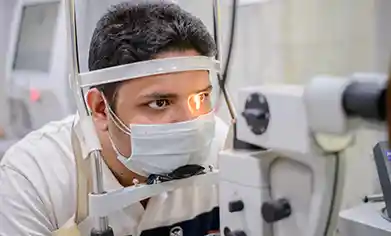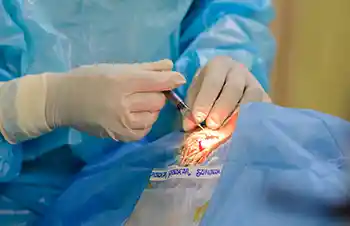They How Diabetes Affects the Eyes
Diabetes impacts various parts of the body, including the eyes. High blood sugar levels can damage the small blood vessels in the retina, leading to diabetic retinopathy. The retina is the light-sensitive tissue at the back of the eye, responsible for converting light into signals sent to the brain. When these blood vessels are damaged, vision problems arise. Some key ways diabetes affects the eyes include:
Diabetic Retinopathy:
The most common eye disease among diabetics, caused by damaged blood vessels in the retina.
Diabetic Retinopathy:
The most common eye disease among diabetics, caused by damaged blood vessels in the retina.
What is a Cataract?
A cataract is a clouding of the eye's natural lens, which leads to vision impairment. It usually develops due to aging but can also result from other factors such as trauma, diabetes, or prolonged exposure to UV rays. Cataracts can affect one or both eyes, and if left untreated, they can lead to significant vision loss over time.
Symptoms of Cataracts
Cataracts can significantly impact daily life by causing a gradual decline in vision quality. Recognizing the
symptoms early can help in timely intervention and treatment. Some of the most common symptoms include:
● Blurry or cloudy vision
● Difficulty seeing at night
● Sensitivity to bright lights
● Faded or yellowish colors
● Double vision in one eye
● Frequent changes in prescription glasses
● Seeing halos around lights
Understanding Cataract Surgery

How Does Cataract Surgery Work?
The surgical procedure is performed under topical anaesthesia and is relatively quick. The surgeon makes a small incision in the eye, breaks up the cataract using ultrasound waves (phacoemulsification), removes the fragments, and inserts an intraocular lens (IOL). The entire process generally takes about 10-15 minutes per eye. The procedure is pain-free and has a high success rate, making it one of the safest surgeries performed worldwide.
Types of Cataract Surgery
There are different types of cataract surgery available, depending on the severity of the condition and the
patient’s specific needs
1. Phacoemulsification (Phaco Surgery)
This is the most common type of cataract surgery. It uses ultrasonic waves to break the cataract into small
pieces, which are then suctioned out. The incision is small and usually heals quickly. This technique allows
for a shorter recovery period and minimal complications.
2. Extracapsular Cataract Extraction (ECCE)
In this method, a larger incision is made to remove the cataract in one piece. It is used in cases where
phacoemulsification is not possible due to an advanced cataract. This method requires a longer healing
time but is effective for severe cataracts.
3. Laser-Assisted Cataract Surgery
This modern technique uses laser technology for more precise incisions and lens fragmentation. It
enhances accuracy and reduces recovery time. Laser surgery is particularly beneficial for patients who
require advanced intraocular lens options.
Benefits of Cataract Surgery
Cataract surgery offers multiple benefits, making it a highly recommended procedure for those suffering
from impaired vision due to cataracts. Some of the key benefits include:
● Restores Clear Vision: Eliminates blurry and cloudy vision.
● Improves Quality of Life: Enhances daily activities such as reading and driving.
● Reduces Dependence on Glasses: Advanced IOLs can correct nearsightedness, farsightedness,
and astigmatism.
● Prevents Vision Loss: Delaying surgery can lead to complications such as blindness.
● Quick Recovery: Most patients resume normal activities within a few days.
● Minimal Risks: The surgery is highly safe, with a success rate of over 95%.
Risks and Complications
While cataract surgery is considered safe, there are some potential risks and complications associated with
it. Understanding these risks can help in making an informed decision.
● Infection or inflammation
● Increased eye pressure (glaucoma)
● Retinal detachment
● Secondary cataract (posterior capsule opacification)
● Temporary vision disturbances
● Swelling of the cornea
Most complications are rare and manageable with proper post-operative care.
Cataract Surgery Recovery
The recovery period is generally short, and most patients experience significant improvement within a few days.
Post-Surgery Care Tips
Proper post-surgery care ensures a smooth recovery and reduces the risk of complications. Following
these guidelines can help in achieving optimal results.
● Use prescribed eye drops to prevent infection.
● Avoid rubbing or pressing the eye.
● Wear protective glasses to shield the eye from dust and bright light.
● Avoid heavy lifting or strenuous activities for a few weeks.
● Follow up with the ophthalmologist for regular check-ups.
● Maintain proper hygiene to prevent infections.
● Sleep with an eye shield for the first few days to protect the eye.
When to Seek Medical Attention
any of the following symptoms, consult your doctor immediately.
● Persistent pain or redness
● Sudden loss of vision
● Flashes of light or floaters
● Excessive swelling or discharge
● Difficulty adjusting to light
Conclusion
Frequently Asked Questions
No, cataract surgery is performed under local topical anaesthesia without any injection, only with
anaesthetic eyedrops, and most patients only feel mild discomfort.
2. How Long Does Cataract Surgery Take?
The procedure typically lasts 10-15 minutes per eye.
3. Can Cataracts Come Back After Surgery?
No, but a condition called posterior capsule opacification (PCO) can occur, which is easily treated with a laser procedure.
4. When Can I Resume Normal Activities After Surgery?
Most patients can resume daily activities within a few days but should avoid strenuous activities for at least a week.
5. Will I Need Glasses After Cataract Surgery?
It depends on the type of IOL used. Multifocal and toric IOLs can reduce dependence on glasses.








